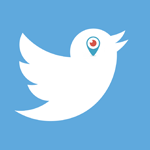 Not long after Twitter acquired Periscope, the video live-streaming app that was in beta at the time of purchase, is released by Twitter on March 26th, 2015.
Not long after Twitter acquired Periscope, the video live-streaming app that was in beta at the time of purchase, is released by Twitter on March 26th, 2015.
The 140-character microblogging service launches Periscope just days after it blocked a rival app Meerkat from accessing its data on who follows whom. Meerkat, which was designed to link with a user's Twitter account, has surged in popularity after becoming a breakout hit.
As a heavy Meerkat competitor, Periscope that was founded by Kayvon Beykpour and Joe Bernsteinacit, allows users to live-stream anything for anyone who wanted to watch. Instead of YouTube that has a passive viewing experience, Periscope gives an active experience where viewers can interact in real time.
But unlike Meerkat, where the live-stream is done for once the user stops it, Periscope allows the live-streamed content to be replayed for 24 hours. Periscope was also more independent from Twitter than Meerkat. Unlike Meerkat, where any engagements are reflected on the users' Twitter profile, all the engagement on Periscope is all kept within the app.
Periscope users can also connect with Twitter so other users can see a link tweeted to see the live-stream. To restrict the audience, Periscope has privacy controls to set who can watch and who can't.
Viewers can comment on the live-stream and send "hearts" if they enjoyed the video. The more "floating hearts" a stream gets, the higher it will be displayed in the "Most Love" list. The stream broadcasters can see in real time which parts of their broadcast are most interesting to the audience.
"What excites us most about Periscope is the power of seeing something for yourself," said Periscope in its blog post. "We've always imagined Periscope as a visual pulse of what's happening right now. Our friends at Twitter felt the same way [...] Twitter brings you closer to people, places, interests, and events in an experience that's immediate, unfettered, and conversational. We think Periscope can help further that mission by giving people a way to share and experience the world around them, both near and far."
The acquisition and the release as a different app is intentional. Twitter took the same strategy when it acquired Vine. The 6-seconds looping video app was also in beta when Twitter acquired it. By keeping it separate from Twitter, Twitter hopes that Periscope can be more than a simple live-stream, and being a standalone product will help it evolve.
Another reason for Twitter to keep Periscope as an independent app is also because it didn't want Periscope to mess with its identity.
"It's really hard to change people's perception of what a product is after it's been around for seven-plus years," explained Periscope co-founder Beykpour. "Though other features deserve to exist within Twitter, I don't think that's the right way to launch a new experience that we think is special."
Meerkat, before Twitter cuts it off, relies heavily on Twitter’s platform. With the relationship between the two product, Twitter was speculated to acquire Meerkat. But instead, it bought Periscope. Being cut off from the popular microblogging site isn't all bad for Meerkat. According to CEO Ben Rubin, the app has more than 400,000 users, and it just raised $14 million in a deal that included Silicon Valley venture capitalists Greylock Partners and Sound Ventures, Ashton Kutcher's fund, making it valued at $52 million.

Social Media in Improvising Social Share
Communicating using the internet has come a long way. On its early days, people are used to talk to others in chat rooms. The phenomenal growth of the internet users demanded new ways to enhance their communication. The internet chat rooms that was still using plain text communication made users create more emotion engagement using colon and a parenthesis - giving birth to emoticons.
When the internet matured a bit more, the internet communities realized that a picture can worth a thousand words, and so then pictures eventually could be sent. And since a video can worth even more than a thousand pictures, video-sharing sites, notably YouTube, came to a rise.
Fast-forward to the modern age of digital media, social media networks have taken much attention in the internet community. More information is shared making communication a lot easier than ever before. With the help of smart mobile devices, the digital world is just as big as your hand.
Recently, tech companies and venture capitalists are spending money and time to see and bet what will become the next big hit that can make communication sharing even better in order to catch more consumers.
"The world is way more ready for this than it was a year ago," said Beykpour.
Driving the shift caused by technological advances and the usage of smart mobile devices, as well as getting people to be comfortable in revealing information about themselves on the internet, is what makes people closer to others no matter where they are or what they do.
"A picture may be worth a thousand words, but live video can take you someplace and show you around," said Twitter said in a post.